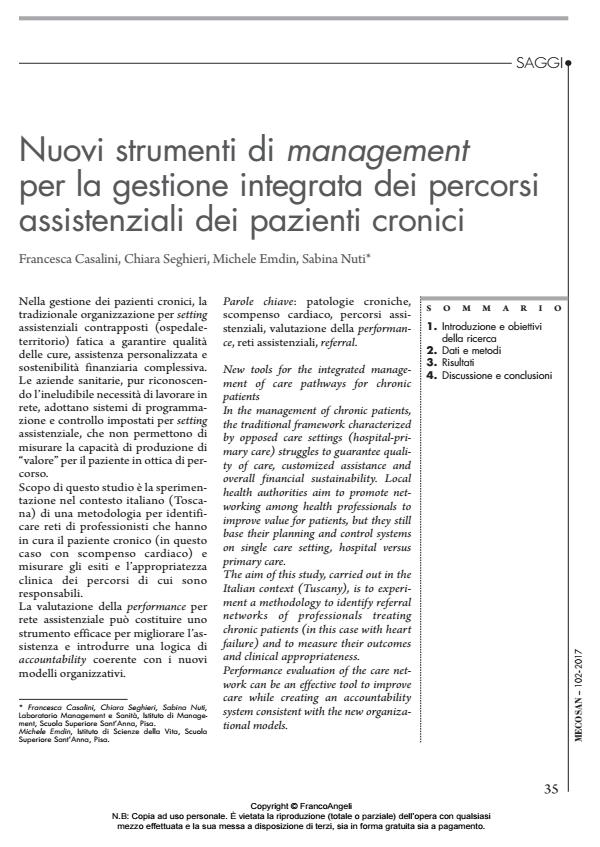Nuovi strumenti di management per la gestione integrata dei percorsi assistenziali dei pazienti cronici
Titolo Rivista MECOSAN
Autori/Curatori Francesca Casalini, Chiara Seghieri, Michele Emdin, Sabina Nuti
Anno di pubblicazione 2018 Fascicolo 2017/102
Lingua Italiano Numero pagine 25 P. 35-59 Dimensione file 23771 KB
DOI 10.3280/MESA2017-102003
Il DOI è il codice a barre della proprietà intellettuale: per saperne di più
clicca qui
Qui sotto puoi vedere in anteprima la prima pagina di questo articolo.
Se questo articolo ti interessa, lo puoi acquistare (e scaricare in formato pdf) seguendo le facili indicazioni per acquistare il download credit. Acquista Download Credits per scaricare questo Articolo in formato PDF

FrancoAngeli è membro della Publishers International Linking Association, Inc (PILA)associazione indipendente e non profit per facilitare (attraverso i servizi tecnologici implementati da CrossRef.org) l’accesso degli studiosi ai contenuti digitali nelle pubblicazioni professionali e scientifiche
Nella gestione dei pazienti cronici, la tradizionale organizzazione per setting assistenziali contrapposti (ospedaleterritorio) fatica a garantire qualità delle cure, assistenza personalizzata e sostenibilità finanziaria complessiva. Le aziende sanitarie, pur riconoscendo l’ineludibile necessità di lavorare in rete, adottano sistemi di programmazione e controllo impostati per setting assistenziale, che non permettono di misurare la capacità di produzione di "valore" per il paziente in ottica di percorso. Scopo di questo studio è la sperimentazione nel contesto italiano (Toscana) di una metodologia per identificare reti di professionisti che hanno in cura il paziente cronico (in questo caso con scompenso cardiaco) e misurare gli esiti e l’appropriatezza clinica dei percorsi di cui sono responsabili. La valutazione della performance per rete assistenziale può costituire uno strumento efficace per migliorare l’assistenza e introdurre una logica di accountability coerente con i nuovi modelli organizzativi.
Parole chiave:Patologie croniche, scompenso cardiaco, percorsi assistenziali, valutazione della performance, reti assistenziali, referral.
- Elementi di performance governance nei servizi sanitari: alcune evidenze empiriche sullo stato dell'arte nella sanità p Fabio De Matteis, in MECOSAN 121/2022 pp.7
DOI: 10.3280/mesa2022-121oa13857 - Enabling Collaborative Governance through Systems Modeling Methods Enzo Bivona, Guido Noto, pp.297 (ISBN:978-3-030-42969-0)
Francesca Casalini, Chiara Seghieri, Michele Emdin, Sabina Nuti, Nuovi strumenti di management per la gestione integrata dei percorsi assistenziali dei pazienti cronici in "MECOSAN" 102/2017, pp 35-59, DOI: 10.3280/MESA2017-102003